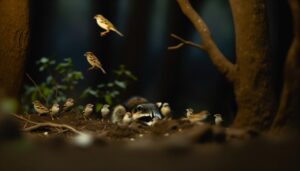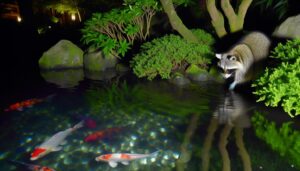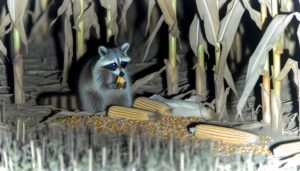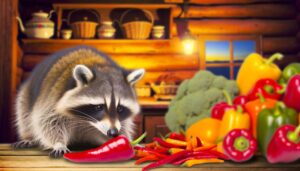Do Raccoons Eat Live Animals?
Raccoons are omnivores, with a diet that includes fruits, nuts, insects, and small animals. While they primarily scavenge, they do occasionally hunt live prey such as mice, frogs, and fish.
This behavior is most evident at night, utilizing their developed senses of sight, smell, and touch. Although instances of raccoons actively hunting and eating live animals are relatively rare, their adaptable nature allows them to exploit various food sources.
This behavior plays a role in ecosystem balance by controlling pest populations. Urban and wild settings influence dietary patterns, offering insights into raccoon feeding strategies across different environments.
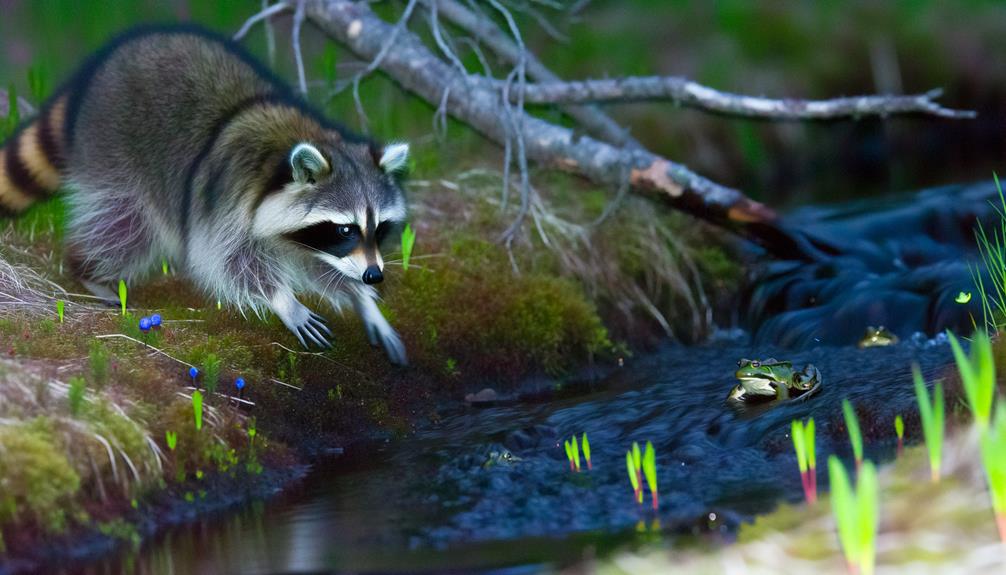
Key Takeaways
- Raccoons are omnivores and occasionally hunt and eat small live animals like mice, frogs, and fish.
- They exhibit opportunistic feeding habits, preferring scavenging over actively hunting live animals.
- Instances of raccoons hunting live prey are rare and not significant in their overall diet.
- Raccoons use their keen senses of sight, smell, and touch to catch slow-moving prey.
- Their adaptable diet includes a wide variety of food items, reducing the need for frequent live hunting.
Raccoon Dietary Habits
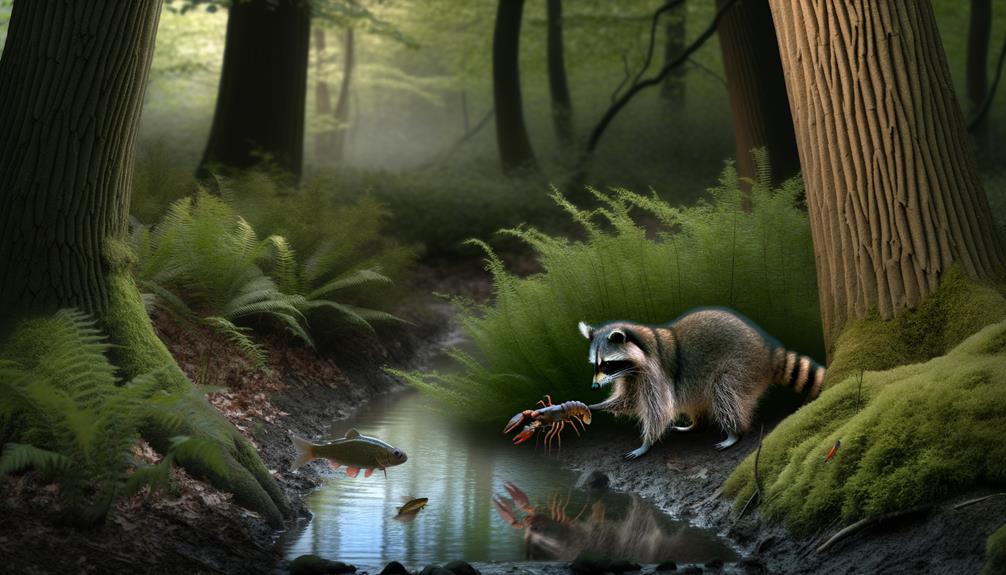
Raccoon dietary habits are diverse and highly adaptive, encompassing a wide range of food sources from plant material to small live animals. This omnivorous species exhibits remarkable flexibility in its diet, thriving in varied environments by consuming fruits, nuts, seeds, and vegetables, depending on seasonal availability.
They also forage for eggs, insects, and small vertebrates, including rodents and amphibians. Observational studies indicate that raccoons are opportunistic feeders, often scouring human refuse for edible remnants. Their ability to exploit different food sources contributes significantly to their success in urban and rural habitats alike.
This dietary adaptability underscores their ecological versatility and survival strategy, allowing them to inhabit diverse ecosystems with fluctuating resources.
Hunting Behavior
Raccoons exhibit distinct nocturnal hunting patterns, primarily foraging during the night to avoid predation and capitalize on the activity of potential prey.
Their prey selection criteria are influenced by the availability and vulnerability of various species, including insects, small mammals, and amphibians.
These behaviors highlight their adaptability and opportunistic feeding strategies.
Nocturnal Hunting Patterns
Under the cover of darkness, these nocturnal mammals exhibit complex hunting behaviors that are both opportunistic and strategic in nature. Raccoons utilize their acute senses of smell, hearing, and touch to navigate and locate potential prey. Their dexterous front paws enable them to manipulate objects, probe crevices, and capture small animals.
This adaptability allows raccoons to exploit a wide range of habitats, from urban environments to dense forests. Observations indicate that raccoons engage in solitary hunting, although they may occasionally forage in loose groups. Their activity peaks during the twilight hours, optimizing their chances of encountering prey while minimizing exposure to predators.
This nocturnal pattern underscores their adaptability and resourcefulness in securing sustenance.
Prey Selection Criteria
The raccoon's prey selection criteria are influenced by factors such as availability, nutritional value, and ease of capture. These omnivorous mammals exhibit opportunistic feeding behaviors, often targeting prey that is abundant and easily accessible. Nutritional value also plays a significant role; raccoons actively seek out food sources rich in protein and fats to meet their dietary needs.
| Factor | Description | Example Prey |
|---|---|---|
| Availability | Prey abundance in the environment | Insects, frogs |
| Nutritional Value | Nutrient content of the prey | Fish, small mammals |
| Ease of Capture | Difficulty level of capturing prey | Eggs, nestlings |
Raccoons employ various hunting strategies such as foraging in water bodies or raiding nests, showcasing their adaptability and resourcefulness in prey selection.
Types of Live Prey
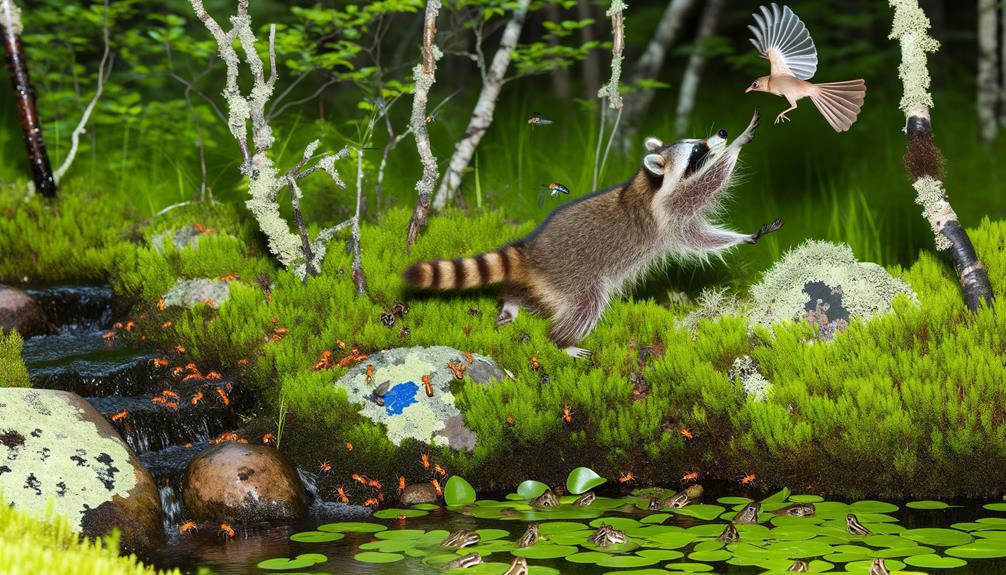
Raccoons exhibit a varied diet that includes a range of live prey such as insects, small mammals, birds, and amphibians. Their opportunistic feeding habits are supported by a suite of hunting techniques tailored to different types of prey, ranging from foraging in shallow water to ambushing terrestrial animals.
This adaptability allows raccoons to thrive in diverse environments, making them successful omnivores.
Common Live Prey
Among the diverse diet of raccoons, common live prey includes small mammals, amphibians, birds, and various invertebrates.
These omnivorous creatures exhibit a remarkable adaptability in their feeding habits, allowing them to exploit a wide range of prey.
Small mammals such as mice and voles are frequently targeted due to their abundance and accessibility.
Amphibians, including frogs and toads, are also integral to their diet, particularly in wetland habitats.
Birds, especially nestlings and eggs, provide a significant nutritional source during the breeding season.
Invertebrates such as insects, crayfish, and worms are readily consumed, often found through foraging in soil or water.
This diverse prey base underscores the raccoon's ecological versatility and opportunistic feeding behavior.
Hunting Techniques Used
Exhibiting a range of sophisticated hunting techniques, raccoons employ various strategies to capture different types of live prey effectively. Their dexterous front paws allow them to manipulate and grasp small animals, such as insects, frogs, and fish.
Raccoons are known to hunt amphibians by patiently waiting near water bodies and using their sensitive paws to detect movements. For capturing birds or small mammals, raccoons leverage their climbing abilities to access nests or burrows. Additionally, they utilize their keen sense of smell to locate hidden prey, often digging to unearth invertebrates.
These behavioral adaptations demonstrate the raccoon's versatile and opportunistic nature, enabling them to exploit a wide range of ecological niches.
Seasonal Variations
The dietary habits of raccoons exhibit notable fluctuations in response to seasonal changes, reflecting the availability of different food sources throughout the year. During the warmer months, raccoons are more likely to consume live prey due to increased activity and abundance of potential food items.
Conversely, their diet shifts significantly in colder months. Key seasonal variations include:
- Spring and Summer: High consumption of amphibians, insects, and small mammals, taking advantage of their increased accessibility.
- Fall: Increased intake of fruits, nuts, and seeds as raccoons prepare for winter, focusing on energy-dense foods.
- Winter: Reduced activity and reliance on scavenging, with a marked decrease in the consumption of live prey due to scarcity.
These patterns highlight the raccoon's adaptive foraging strategies.
Impact on Ecosystems
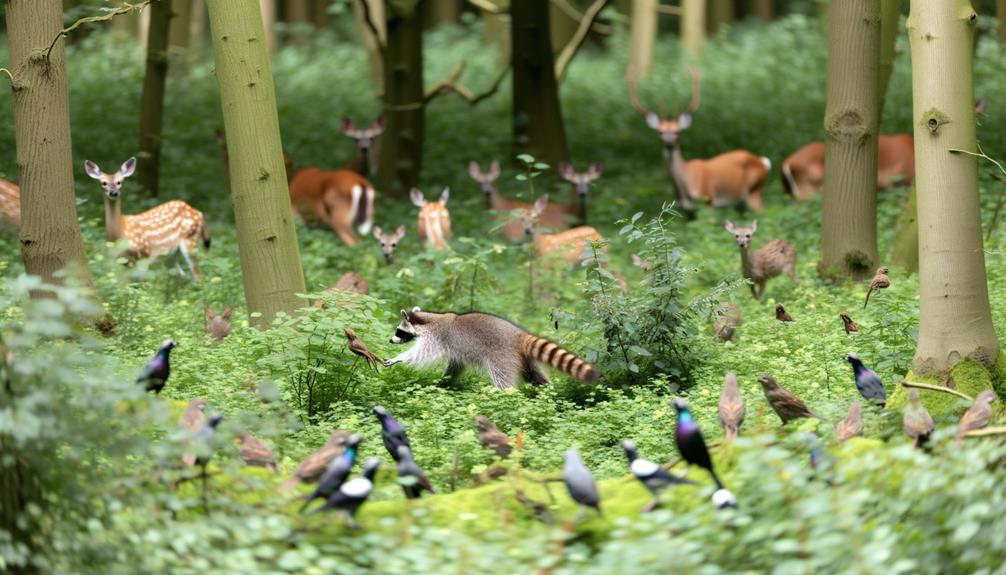
Understanding how raccoons' seasonal dietary shifts influence their ecosystems is pivotal for comprehending their role in various habitats. Raccoons exhibit omnivorous feeding habits, consuming a diverse array of food sources ranging from fruits and nuts to small vertebrates and invertebrates.
These dietary shifts can significantly impact local food webs, as raccoons may regulate populations of both prey and plant species. For example, by preying on small animals, raccoons can control pest populations, thereby affecting the prevalence of certain insects and rodents. Conversely, their consumption of fruits aids in seed dispersal, promoting plant diversity.
Such interactions highlight raccoons' intricate involvement in ecosystem dynamics, making them a key species in maintaining ecological balance.
Comparing Urban and Wild Diets
Contrasting their wild counterparts, urban raccoons adapt their diets to include a higher proportion of human-derived food sources, such as garbage, pet food, and discarded scraps. This adaptation is driven by the availability and ease of accessing these resources in urban environments.
In the wild, raccoons maintain a more varied and natural diet, consisting primarily of:
- Small mammals and insects: Providing essential protein and fat.
- Fruits and nuts: Contributing essential vitamins and minerals.
- Aquatic organisms: Including fish and amphibians, adding diversity.
Urban raccoons exhibit a behavioral shift to opportunistic foraging, leading to increased human-wildlife interactions. Understanding these dietary differences is crucial for managing raccoon populations and mitigating potential conflicts in urban areas.
Conclusion
Raccoons exhibit diverse dietary habits, including the consumption of live prey such as insects, amphibians, and small mammals, which vary seasonally.
How does this predation impact local ecosystems?
The predatory behavior of raccoons influences prey populations and contributes to ecological balance.
Comparatively, urban raccoons adapt to available resources, integrating human-derived foods into their diet, whereas wild raccoons rely more on natural prey.
Understanding these dietary patterns is essential for ecosystem management and conservation efforts.


